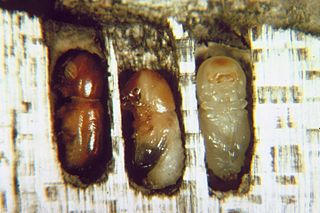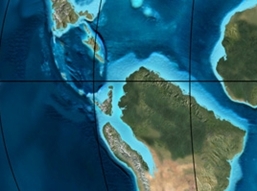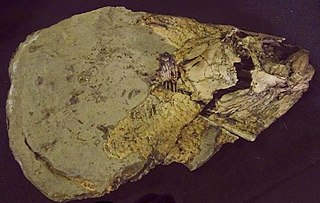Related Research Articles

Banana slugs are North American terrestrial slugs comprising the genus Ariolimax.

The tundra swan is a small Holarctic swan. The two taxa within it are usually regarded as conspecific, but are also sometimes split into two species: Bewick's swan of the Palaearctic and the whistling swan proper of the Nearctic. Birds from eastern Russia are sometimes separated as the subspecies C. c. jankowskii, but this is not widely accepted as distinct, with most authors including them in C. c. bewickii. Tundra swans are sometimes separated in the subgenus Olor together with the other Arctic swan species.

Dendropsophus columbianus is a species of frog in the family Hylidae. It is endemic to the Andes of Colombia. Dendropsophus columbianus is a common and adaptable species that lives in disturbed areas that formerly supported cloud forests; it has not been found in closed forests. It is typically associated with open habitats, especially those with some waterbodies.
Epicrionops columbianus, the El Tambo caecilian, is a species of caecilian in the family Rhinatrematidae endemic to Colombia. It is known from the western slopes of the Cordillera Occidental in Cauca and Chocó Departments.
The speckle-breasted wren is a species of bird in the family Troglodytidae. It is found in Colombia, Ecuador, and Peru.

The Columbian ground squirrel is a species of rodent common in certain regions of Canada and the northwestern United States. It is the second largest member of the genus Urocitellus, which is part of the tribe Marmotini, along with marmots, chipmunks, prairie dogs, and other holarctic ground squirrels. They are stout, with short dense fur, which is characteristically tawny across the bridge of the nose. Social encounters often are initiated with kissing behavior and the most common activity above ground is standing at attention. Residing in mountainous terrain and high plains in northern latitudes, they hibernate most of the year in burrows, which may be used for many years. They are emaciated when emerging in the spring. These long periods of torpor earned the squirrels the moniker "Seven Sleepers", since the rests last around seven months. The Columbian ground squirrel came to the attention of the scientific community through writings produced by Lewis and Clark, while 21st century molecular genetics has more finely illuminated its ties with other close relatives.

Yaguarasaurus is an extinct genus of mosasauroid from the Late Cretaceous (Turonian) period of Colombia, South America. The remains discovered were defined as a new genus and species of mosasaurid, Yaguarasaurus columbianus, by the Colombian paleontologist María Páramo, former director of the Museo de Geología José Royo y Gómez of INGEOMINAS in Bogotá. The first fossils remains of this animal suggested a cranial length of 47 centimetres (19 in) and a total length of 5 metres (16 ft); an additional skull that measures 87 centimetres (34 in) long implies a larger size.
The bridgelip sucker is a fish in the family Catostomidae that occupies the Columbia River system. Like all sucker fish, they live only in fresh water. Bridgelip suckers have a tendency to live in deeper waters during the day and move into shallower water around evening time. As adults they eat periphyton. Adolescents, however, eat aquatic hatchlings and zooplankton. Adult bridgelip sucker range in size from 5 inches to 17 inches. They spawn around May, when the water temperature is between 8-13 C, and lay somewhere around 9,955 and 21,040 eggs. Inside of the Columbia River system, the bridgelip sucker shares much of its territory another similar looking sucker, the largescale sucker.

Corthylus columbianus, also known as the chestnut timber worm or the Columbian timber beetle, is a beetle of the family Curculionidae.

Nätsi-Võlla Nature Reserve is a nature reserve situated in western Estonia, in Pärnu County, made up of several bogs that together form the largest bog area in Pärnu County.

Onciderini is a tribe of longhorn beetles of the subfamily Lamiinae, they are prevalent across Europe in nations such as Turkey, and Finland.
Clavidesmus is a genus of longhorn beetles of the subfamily Lamiinae, containing the following species:
Clavidesmus funerarius is a species of beetle in the family Cerambycidae. It was described by Lane in 1958, originally under the genus Orteguaza. It is known from Bolivia.
Clavidesmus indistinctus is a species of beetle in the family Cerambycidae. It was described by Dillon and Dillon in 1952. It is known from Brazil.
Clavidesmus lichenigerus is a species of beetle in the family Cerambycidae. It was described by Lane in 1958, originally under the genus Orteguaza. It is known from Peru, Colombia, Brazil, and Honduras.
Clavidesmus metallicus is a species of beetle in the family Cerambycidae. It was described by James Thomson in 1868. It is known from French Guiana.
Clavidesmus monnei is a species of beetle in the family Cerambycidae. It was described by Giorgi in 1998. It is known from Brazil.

The La Frontera Formation (Spanish: Formación La Frontera, K2F, Ksf) is a geological formation, part of the Villeta Group, of the Altiplano Cundiboyacense and neighbouring areas of the Eastern Ranges of the Colombian Andes. The sequence of limestones and lydites dates to the Late Cretaceous period; Turonian epoch and has a maximum thickness of 206 metres (676 ft).

The Hondita Formation is a fossiliferous geological formation of the Upper Magdalena Valley (VSM) and surrounding Central and Eastern Ranges of the Colombian Andes, extending from Cundinamarca in the north to Huila and easternmost Tolima in the south. The lowermost unit of the Güagüaquí Group, a sequence of sandy limestones and shales, dates to the Late Cretaceous period; Turonian epoch, and has a maximum thickness of 90 metres (300 ft).

Bachea is an extinct genus of ray-finned fish that lived during the Late Cretaceous in what is now central Colombia, South America. The type species is B. huilensis, described in 1997 by María Páramo from the Turonian of Huila, Colombia.
References
- ↑ BioLib.cz - Clavidesmus columbianus. Retrieved on 8 September 2014.